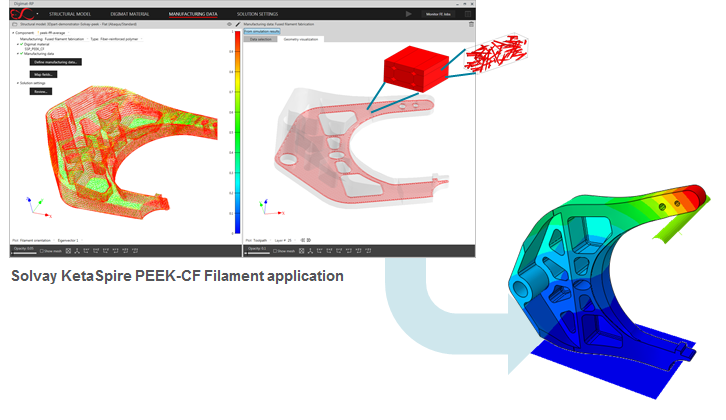“The overall goal in the application of our solutions is to develop tools that can speak “the AM language” to deliver AM-designed parts”
The last three years of the 3D Printing software environment have been marked by “simulation” software tools, yet manufacturing simulation software tools are not anything new. The concept has been around for many years and in order to understand its basic principles, we discussed with e-Xstream. #OpinionofTheWeek
Established in 2003, e-Xstream engineering is a spin-off of Université Catholique de Louvain (Belgium), that provides a simulation software platform called DIGIMAT for the modeling of composite materials. Over time, the company has built up extensive expertise in the field and is now part of MSC Software which itself is part of Hexagon, a global provider of information technologies. These mergers and acquisitions enable Hexagon AB through its companies to provide a full range of software solutions across vital industries (aerospace, automotive, healthcare and many more).
However, in order to understand how this environment works, we spoke to Olivier Lietaer. As the Business Development Engineer of the company, he connects with the AM industry to understand their needs and turns them into solutions by closely working with their product development team. To explain what brought the company to AM simulation, Olivier Lietaer explained: “on the industry side, we want to help accelerate the adoption of AM thanks to numerical simulation, in close collaboration with our ecosystem. On the technical side, since the very beginning, e-Xstream aims to explain the materials behavior and the part performance thanks to the way the material has been manufactured. Given the key role of materials in additive manufacturing, especially plastics and composites, it was natural for us to expand our services to AM.”

However, among the challenges that might slow down an effective AM process, the Business Development Engineer points out the limited number of materials as well as the uncertainty that arouses when it comes to the design accuracy or the mechanical properties of the final part.
According to Olivier Lietaer, simulation software providers therefore come into play to save time and money by predicting how the part will behave at the software level, way before the printing process.
The three levels that matter (for e-Xstream)
When it comes to additive manufacturing, e-Xstream explains that its simulation software services are offered at three levels: materials engineering, process simulation and part performance. “Materials Engineering consists in simulating the material behavior, which is determined from the bulk material properties and as-printed material microstructure.
Process simulation basically aims at predicting the dimensional accuracy of the part, the level of distortion that you might end up with and anticipating some printing issues.
Lastly, by combining materials engineering and process simulation, we have the key ingredients to accurately predict the part performance in function of the material and printing setup. The overall goal in the application of our solutions is to develop tools that can speak “the AM language” to deliver AM-designed parts”, adds Olivier Lietaer.

The transition from rapid prototyping to actual production of parts requires to replicate the traditional engineering workflow to optimize the process and validate the design. As per Olivier Lietaer’s words, by going through these stages, engineers will be able to reduce trials and errors as much as possible.
“With the Hexagon tools, we offer a complete end-to-end solution with complementary manufacturing solutions, at the metrology level, the hardware and the software to connect digital and real worlds. In other terms, we can anticipate warpage during the design phase, print the part and control its quality at the end of the printing process”, said Olivier Lietaer.
This being said, we understand that e-Xstream engineering is able to provide its customers with a full simulation chain that is compatible with FDM and SLS technologies and embeds a large composite materials’ database. Thanks to these tools, users can significantly reduce physical tests and understand key parameters driving the material and process behavior.
Outlooks
Due to their ability to control the entire manufacturing process at the digital level, simulation tools can achieve tons of benefits. Engineers can harness them during the design process to automate and inform but also to ensure the validation of parts.
On the other side, simulation software services providers can work with both manufacturers of 3D Printers and materials suppliers to help them thrive. Stratasys and Solvay are even some of the partners with whom e-Xstream collaborates at the hardware and the material levels. In this vein, Olivier Lietaer announces the company’s willingness to extend their solutions to further technologies, 3D printers and materials.
Although this conversation features the importance of simulation in an additive manufacturing process, it also underlines a certain quest for simulation accuracy that seems to be a never-ending one for companies of the industry. The reason would be obvious: provide the best service possible and get more and more customers.
However, this debate is certainly not over as it raises other interesting questions about the gap that exists between those who take advantage of simulation software tools and those who aren’t actually aware of their potential or who simply do not care. Lastly, a comparison of these patterns given by e-Xstream with other companies’ patterns seems now necessary in order to draw a unique guideline of these processes.
For further information, follow us on our social media and subscribe to our newsletter! Would you like to be featured in the next issue of our digital magazine? Send us an email at contact@3dadept.com






